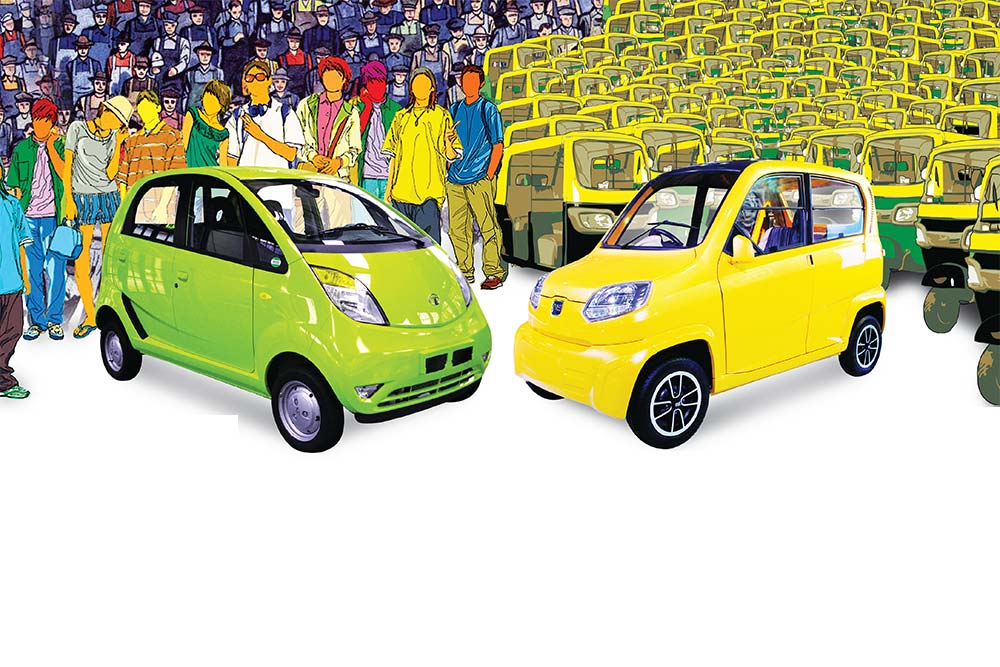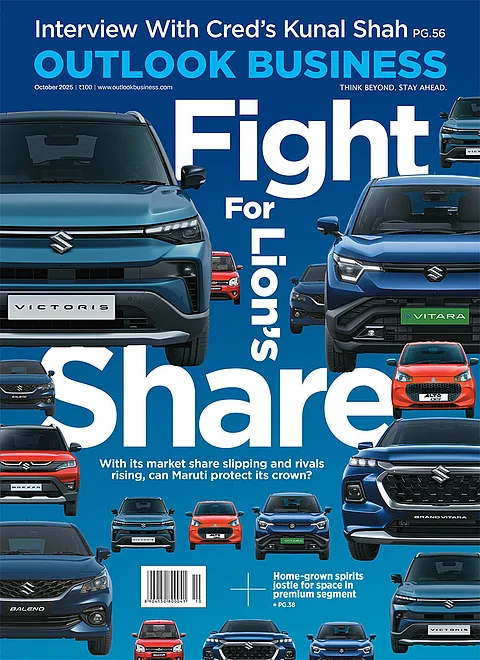Remember the recent ad for a “caaaaaar”? The first glimpse of the RE60 may have had you saying something similar, with a slight change in inflection to: “car???????” Indeed, Bajaj Auto’s new four-wheeler looks more like a child’s toy than a vehicle that is supposed to ferry four adults and a driver from point A to point B. But the Pune-based company does not want its new vehicle to be clubbed with the various small cars crowding India’s roads or, worse, comparisons with Tata Motors’ Nano. Indeed, Bajaj Auto is at pains to declare that the RE60 is not a car at all.
Still, comparisons between the RE60, which was unveiled at the Auto Expo in Delhi last month, and the revamped Nano, which was launched in November, are inevitable. Both are extremely small vehicles, priced to appeal to the common man and by the time they finally hit the roads, had become an uneasy reflection of their company’s health. And, although it is early days yet, both seemed poised for a bumpy ride ahead.
How are the new small wonders of the Indian auto industry going to reach out to their target customers? What different strategies will they adopt? And, most importantly, will they succeed?
RE60: Auto drive
Despite all his protests about being “anti-car”, Bajaj Auto managing director Rajiv Bajaj was expected to showcase a small passenger car at the Auto Expo. What he finally unveiled — and which had been in the making for nearly five years — was a souped-up version of the ubiquitous autorickshaw. The RE60 is not a car, Bajaj insisted; it is just a four-wheeeler. Which means it is not even in the same space as the Nano. Instead, Bajaj wants it to replace the fleet of nearly a million autorickshaws across India.
Whether that happens or not, industry analysts unanimously agree on certain points: the RE60 is not a challenger to the Tata Nano at any level. It will take at least two or three years after its launch for the vehicle to make any significant impact on the company’s bottomline. And it is also not an aspirational product that can lift the Bajaj brand in any way.
The RE60 is also a latecomer to the small vehicle party: Tata Motors’ Iris was launched last year as a four-wheel, four-seater public vehicle. Of course, Bajaj has traditionally been a slow-mover when it comes to new product lines. It continued making geared scooters through the 1990s even as customers moved up to small cars from Maruti and, later, Hyundai. The Pulsar motorcycle, which went on to change the company’s fortunes, wasn’t launched until end-2001. Even in the three-wheeler segment, which it has dominated for nearly four decades, Bajaj didn’t realise the potential for a three-wheeler goods carrier until much later, by which time Piaggio had already captured the category. Tata’s Iris has similarly created a new category.
The editor of a leading car magazinecalls the Bajaj RE60 “a three-wheeler with four wheels”. “It is not a huge achievement from an automotive point of view,” he says. “Bajaj Auto has been pragmatic. RE60 just goes to show that it is incredibly difficult to get into the passenger car segment. Developing a car is not easy.”
An auto consultant who was part of the team working on RE60 points out that the original idea was to launch a small car (Rajiv Bajaj’s claims notwithstanding). But, he says, “The math didn’t work out. Getting price points right is not easy.” Instead of trying to squeeze out a car on an auto budget (and then selling it dirt cheap, a la the Nano, which overshot its budget several-fold but stuck to the Rs 1 lakh price tag during its launch), Bajaj Auto decided to stay with what it knows best: the rear engine, last mile people carrier.
Now that it has finally got the vehicle off the blocks, what will Bajaj do with the RE60? It is the market leader in autorickshaws; won’t the RE60 cannibalise its own product? Rajiv Bajaj doesn’t think so. He recently told an online management journal that the launch of the four-wheeler is about “creating a new category and providing more options.” Bajaj did not reply to an email questionnaire sent by Outlook Business.
Just how welcome will those options be? Anyone who’s travelled in an autorickshaw will aver that the vehicle feels like a death-trap on wheels, and exposes passengers and drivers to dust and pollution. However, in many ways, it is also ideal for crowded Indian city roads: it takes up less space, is easily manoeuvred and has a short turning radius.
The lack of those attributes — and the still unknown maintenance cost of the vehicle —may be a strike against the RE60 when it comes down to customers’ purchase decisions.
There is another very important determinant for RE60’s success on the roads: government policies. “It is not yet clear whether existing three-wheeler permits will be converted into permits for RE60 [a four-wheeler] or entirely new permits have to be taken,” says Shivram Poojary, a Bajaj Auto three-wheeler dealer in Navi Mumbai. Currently, the regional transport offices in cities like Mumbai do not issue any new permits for three-wheelers. Existing permits are traded between drivers for ₹1 lakh for a five-year period.
The RE60 will not cost much more than an autorickshaw (expected to be priced at ₹1.5-1.75 lakh versus ₹1.3 lakh for an autorickshaw) and the added advantage that it has is the full weight of the Bajaj Auto distribution network (nearly 500 dealers and 1,500 service centres across India) behind it. Whether that will be enough to drive sales of the RE60 remains to be seen.
Nano: Second life
There was so much fanfare when Tata Motors finally rolled out the Nano in 2009. It was touted as the great hope of the Indian middle class, the car that would allow families to travel together in safety and comfort — and not break the bank, either. But that was then. Relocating the plant from West Bengal to Gujarat disrupted production schedules and delayed deliveries. Then, safety concerns over manufacturing flaws made buyers cancel bookings.
It did not help that Tata Motors seemed to expect the Nano to sell by itself. The first TV commercial for the car was aired only two years after the launch and it stuck to the original brief, portraying a lower-income family in small-town India. Not surprisingly, not only was there no brand connect with urban Indians, there was no aspirational value attached to the car. The result: Against an installed capacity of 250,000 cars a year, Tata Motors sold 70,432 Nanos in FY11 and 47,112 units in FY12 till date, according to data from the Society of Indian Automobile Manufacturers (Siam). The original target of 25,000 units a month now seems a distant dream. So much so that even Tata group chairman Ratan Tata recently called the Nano, his pet project, a “failed opportunity”.
Siddharth Singh, associate professor of marketing at Hyderabad’s Indian School of Business, says Tata should not have presented Nano as a cheap car. Instead, it should have been showcased as a better-value alternative to entry-level cars. “Aspirational consumers may not want to buy a cheap car midway between a ‘real’ car and a two-wheeler,” he says. “They may be interested in a ‘real’ car even if they have to pay a little more.”
That change is now happening. An updated version of the Nano was launched a couple of months ago, and it came with better mileage and air-conditioning. Features like booster-assisted brakes (which provide additional brake power so the driver does not need to exert unnecessary force), which were earlier available only in the higher end models, have now been added even to the standard model. The interiors have been upgraded to look more premium and eight new colours with exotic names like neon rush, mojito green and meteor silver have been introduced. Significantly, the Nano’s USP — its price — remains unchanged.
The company’s plan is fairly simple — and quite obvious. It is time to steer the Nano away from its ‘poor man’s drive’ image that seems to have stuck to it. The latest advertising campaign for the Nano 2012 shows a group of young friends zipping through bumpy terrain and highways for a cup of tea. “The focus for the new communication was to showcase the car’s capabilities and performance,” points out Sarita Raghavan, business head, Rediffusion Y&R, Tata Motors’ ad agency. She adds that the two-month-old campaign is already showing results. “The commercial has over 100,000 hits online and there has been an increase in walk-ins and enquiries at dealerships.”
But an ad campaign alone won’t be enough to solve all that ails the Nano. Tata Motors is also ensuring that distribution and financing are in order. Easier and faster loans, exclusive showrooms in tier 3 and tier 4 cities and the option to buy an extended warranty and maintenance contract for a token amount (₹99) are just some of the ways by which it is wooing buyers back.
Will all this work? Harish Bijoor, CEO of the Bangalore-based brand consultancy that goes by his name, has his doubts. “Tata Motors has changed gears completely from its last campaign and such drastic change brings the danger of inconsistency in the message. And while this campaign will work with urban consumers, will it connect with the tier 3 and 4 markets? I’m not so sure.”












 Just one email a week
Just one email a week